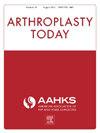Utility of Frailty Index in Predicting Discharge Disposition and Prolonged Length of Stay Following Enhanced Recovery After Surgery Protocol Total Hip and Knee Arthroplasty
IF 2.1
Q3 ORTHOPEDICS
引用次数: 0
Abstract
Background
Predictive tools such as the risk assessment and prediction tool (RAPT) and the 5-item modified Frailty Index (mFI-5) have been created to assist in discharge planning after total joint arthroplasty (TJA) including hip and knee arthroplasty, but there is no uniform determination of frailty risks. The primary objective was to compare the modified Frailty Index and RAPT in assessing outcomes following TJA, and we hypothesized similar performance between both measures.
Methods
We conducted a retrospective study of patients aged 50 years and more undergoing primary elective TJA at a single academic tertiary center through the same Enhanced Recovery After Surgery protocol. Patients were stratified using mFI-5 and RAPT scores tabulated during preoperative clinic visits. Multivariable analyses were conducted to assess independent associations of mFI-5 and RAPT with complications, prolonged length of stay, readmissions, and nonhome discharge. Youden’s index was used to construct receiver operating characteristic curves to assess the predictive ability of mFI-5, Charlson Comorbidity Index, and RAPT in classifying outcomes.
Results
A total 858 TJA patients were included. Overall, 547 (63.8%) were not frail, 273 (31.8%) were prefrail, and 38 (4.4%) were frail. When stratifying by RAPT, 369 (43.0%) had RAPT > 9 (low-risk), 402 (46.9%) had RAPT 6-9 (moderate-risk), and 87 (10.1%) had RAPT < 6 (high-risk). Prefrailty (odds ratio [OR]: 2.31, P = .006) and frailty (OR: 8.82, P < .001) were associated with higher nonhome discharge. Both RAPT 6-9 (OR: 4.87, P = .001) and RAPT < 6 (OR: 27.2, P < .001) were associated with nonhome discharge. Neither was independently associated with complications or readmissions. These indices were poor independent predictors of complications, readmissions, and prolonged length of stay (all, area under the curve [AUC] < 0.7). While RAPT demonstrated the greatest discriminative ability in identifying nonhome discharge (AUC: 0.772), mFI-5 (AUC: 0.720) was also an acceptable predictors of nonhome discharge.
Conclusions
The mFI-5 performs similarly to RAPT in predicting 30-day TJA outcomes. Using the mFI-5 may aid preoperative risk stratification to optimally identify candidates for home discharge.
虚弱指数在预测全髋关节和膝关节置换术后增强恢复后出院处置和延长住院时间中的应用
为了辅助包括髋关节和膝关节置换术在内的全关节置换术(TJA)术后的出院计划,已经创建了诸如风险评估和预测工具(RAPT)和5项修正的衰弱指数(mFI-5)等预测工具,但目前还没有统一的衰弱风险确定方法。主要目的是比较改良后的虚弱指数和RAPT在评估TJA后的结果,我们假设两种测量方法的表现相似。方法:我们对50岁及以上的患者进行了回顾性研究,这些患者在一个学术三级中心接受了相同的增强术后恢复方案的原发性选择性TJA。患者在术前就诊时使用mFI-5和RAPT评分表进行分层。进行多变量分析以评估mFI-5和RAPT与并发症、延长住院时间、再入院和非家庭出院的独立关联。采用约登指数构建受试者工作特征曲线,评价mFI-5、Charlson合并症指数和RAPT对预后分类的预测能力。结果共纳入TJA患者858例。总体而言,547例(63.8%)不虚弱,273例(31.8%)虚弱,38例(4.4%)虚弱。用RAPT分层时,369例(43.0%)有RAPT;9例(低危),402例(46.9%)有RAPT 6-9(中危),87例(10.1%)有RAPT <;6(高风险)。偏好(优势比[OR]: 2.31, P = 0.006)和脆弱(优势比[OR]: 8.82, P <;.001)与较高的非家庭出院率相关。RAPT 6-9 (OR: 4.87, P = .001)和RAPT <;6 (OR: 27.2, P <;.001)与非家庭出院相关。两者均与并发症或再入院无关。这些指标不是并发症、再入院和延长住院时间(即曲线下面积[AUC] <;0.7)。虽然RAPT在识别非家庭出院方面表现出最大的判别能力(AUC: 0.772),但mFI-5 (AUC: 0.720)也是一个可接受的非家庭出院预测因子。结论mFI-5在预测30天TJA预后方面与RAPT相似。使用mFI-5可能有助于术前风险分层,以最佳地确定家庭出院的候选人。
本文章由计算机程序翻译,如有差异,请以英文原文为准。
求助全文
约1分钟内获得全文
求助全文
来源期刊

Arthroplasty Today
Medicine-Surgery
CiteScore
2.90
自引率
0.00%
发文量
258
审稿时长
40 weeks
期刊介绍:
Arthroplasty Today is a companion journal to the Journal of Arthroplasty. The journal Arthroplasty Today brings together the clinical and scientific foundations for joint replacement of the hip and knee in an open-access, online format. Arthroplasty Today solicits manuscripts of the highest quality from all areas of scientific endeavor that relate to joint replacement or the treatment of its complications, including those dealing with patient outcomes, economic and policy issues, prosthetic design, biomechanics, biomaterials, and biologic response to arthroplasty. The journal focuses on case reports. It is the purpose of Arthroplasty Today to present material to practicing orthopaedic surgeons that will keep them abreast of developments in the field, prove useful in the care of patients, and aid in understanding the scientific foundation of this subspecialty area of joint replacement. The international members of the Editorial Board provide a worldwide perspective for the journal''s area of interest. Their participation ensures that each issue of Arthroplasty Today provides the reader with timely, peer-reviewed articles of the highest quality.
 求助内容:
求助内容: 应助结果提醒方式:
应助结果提醒方式:


